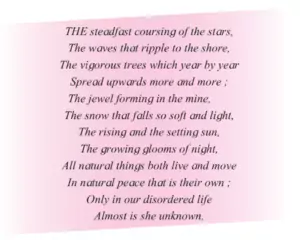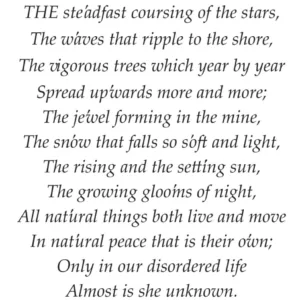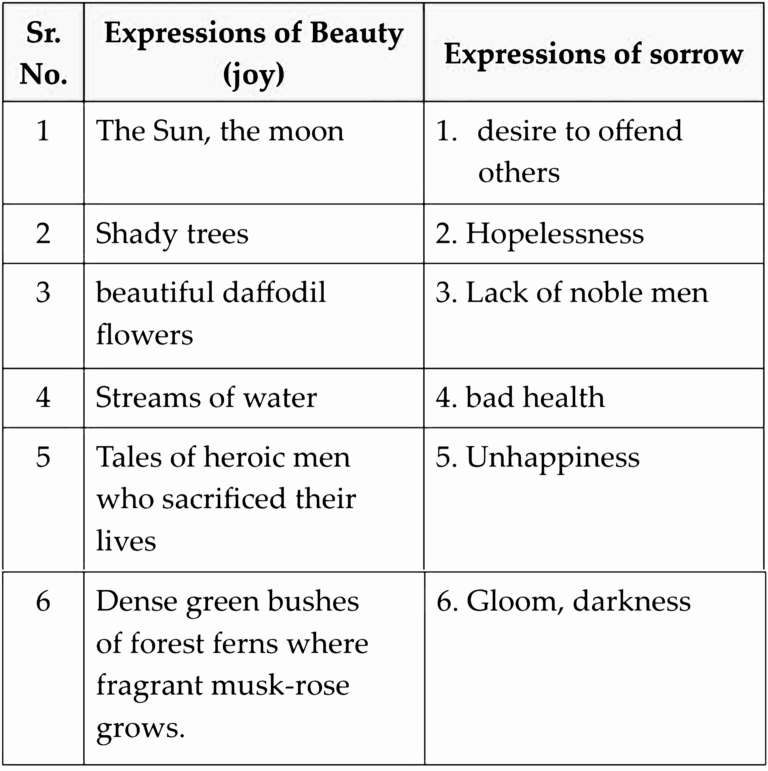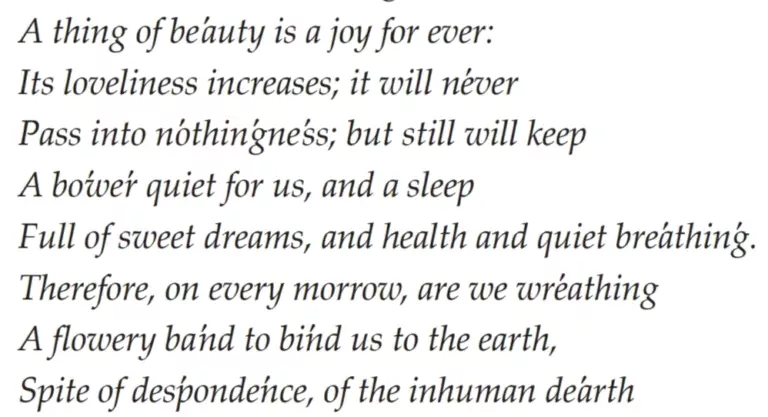Chapter 4.1 – A Thing of Beauty is a Joy For Ever
The poet says that beauty is eternal; it never fades away, but instead our love for it enhances with the passage of time. The poet’s view of beauty is that it never ends. Beauty acts like the soothing, relaxing shade of the trees, which helps all the creatures to sleep peacefully and enjoy good health.
The poet names some of the things whose beauty is eternal. The sun, moon, greenery like trees, whose shade is a boon for creatures like the sheep to rest under it; various flowers like daffodils; rivers, full of clear waters, which cool everyone in the summers; the thick bushes of forest fern where beautiful fragrant musk-rose bloom. Other than these things of nature, the poet says that the stories of brave men who sacrificed their lives are also beautiful. All these beautiful things are like nectar for us. It’s God’s gift to us, which helps us live further on this earth.
Title:
‘A Thing of Beauty Is a Joy Forever’
Poet: John Keats
Rhyme scheme:
The poem has a rhyme scheme – aabb throughout
Favourite line:
My favourite line is, ‘A thing of beauty is a joy forever’ because I feel that it is very true and that anything beautiful in nature can give us never-ending joy.
Theme/Central idea:
The central idea conveyed through the poem is that the loveliness contained in things of beauty is everlasting, and they enhance each moment but will never cease to be. One can keep relishing its sweetness at all moments, irrespective of the limits of time and space.
Figures of speech:
The figures of speech used to enrich the poem include alliteration, anti-climax, antithesis, assonance, climax, consonance, epigram, metaphor, onomatopoeia, and personification.
Special features:
The special feature of the poem are the many lines containing imagery. The reader forms mental pictures and enjoys the poem.
Why I like the poem:
I like the poem because it makes me think.
bower : a pleasant shady place under trees or climbing plants
morrow : the following day
wreathing : (here) weaving with flowers
spite of despondence : in spite of despair
dearth : shortage
pall : a sheet spread over the dead
boon : gift
rills : streams
covert : (here) shade
brake (Archaic) : ferns
dooms : last day of existence known or displayed
brink : edge
poesy : poetry
o’ercast : spread above
Warming up!
1. (A) Fill in the Acrostic with names of things related to Nature.
Ans:
B – Butterfly/Bananas
E – Evening sunset
A – Arrangement of flowers
U – Uniform rows of pink roses
T – Tropical forests
Y – Yonder hill
(B) Make a list of 10 words related to the word ‘joy’, for example, happiness.
Ans:
(1) ecstasy
(2) bliss
(3) delight
(4) pleasure
(5) gladness
(6) glee
(7) cheer
(8) excitement
(9) rapture
(10) satisfaction
2. Recollect a picnic or a trip to a spot of natural beauty (a hill station / a beach / forest area etc.) when you were younger.
Write four beautiful unforgettable scenes that left a deep impact on you.
Ans:
(i) The breathtaking scenery of the spectacular landscapes, the abundance of greenery and orchards in Himachal Pradesh makes a visit to this place, an-out-of-the world experience for any tourist.
(ii) At every turn there was something new to see. Out of earth and rock and leafless bough, the magic touch of the monsoon rains had brought life and greenery.
(iii) We went to a rocky beach and saw the spread of the majestic ocean and the rocks alongside those carved, sculpted and shaped by the water.
(iv) From the watch tower of the Prongs Reef Lighthouse, which is surrounded on all sides by the Arabian sea, the man had heard the sea rage like a possessed spirit, the darkness dispelled only by the beam of light, flung across the waters from the tower he mans.
3. ‘Meter’ in poetry is a pattern of stressed and unstressed syllables in lines of a poem. It gives rhythm to the poem.
Read the poem below aloud and with any coloured pen/ pencil put stress-marks ( ) on those syllables that are stressed in the words of the poetic lines.

Ans:

4. Consonance and Assonance
Consonance : Repetition of consonant sounds within a word, phrase or a short sentence.
For example : pitter-patter/ chuckle-fickle/ sick-duck/ Betty bought some bitter butter
Assonance : Repetition of vowel sounds within a word/ phrase/ sentence.
For example : Jack had a bag.
Men sell metal- kettle.
Let the engineer steer without fear.
(Note : Here, the focus is on pronunciation and not on the spellings of words)
From the above poem pick out examples of consonance and of assonance within words / phrases.
Ans:
Consonance:
(1) The steadfast coursing of the stars
(2) The waves that ripple to the shore
(3) The snow that falls so soft and light
(4) The rising and the setting sun
(5) All natural things both live and move.
Assonance:
(1) The vigorous trees which year by year
(2) Spread upwards more and more
(3) Theewel forming in the mine
(4) Only in our disordered life.
In Between The Poetry
Q1. List the things of beauty mentioned in the poem.
Ans: All beautiful things of nature are a boon for human beings. The sun; the moon; the trees, daffodils, simple sheep, clear streams, ferns, musk-rose, etc. provide us peace and happiness.
Q2. List the things that cause suffering and pain.
Ans: Disease, disappointments, jealously, lack of human qualities, gloomy days, unhealthy and evil ways cause pain and suffering in our lives.
ENGLISH WORKSHOP
1. Read the poem and fill in the table.

Ans:

2. Answer in your own words.
(a) What is the impact of a beautiful thing on us?
Ans: A beautiful thing leaves a permanent impression on our minds. Its loveliness goes on increasing. It stays in our imagination and becomes a source of joy forever.
(b) What does a thing of beauty keep in store for us?
Ans: The effects of the things of beauty permanently charm our senses. They do not fade with time and stay in our senses. No time and space can put an end to the effect of the beauty of objects.
(c) Who are the mighty dead? Why are they attributed with ‘grandeur’?
Ans: The mighty dead are those who have sacrificed their lives for a noble cause and made great achievements in their lifetime. The mighty dead are honoured and worshipped for their remarkable achievements. Now they are lying buried under their graves. On the day of judgement God also will reward them for their noble deeds. It is this dignity that is associated with them.
(d) How does the memory of a beautiful visual scene become a joy forever?
Ans: Beautiful things are like an endless fountain which goes on pouring the immortal drink unto us from the heavens. They are a source of immense joy and happiness.
3. Pick out and rewrite 5 lines that contain Imagery.
For example :
(a) we are wreathing a flowery band…
Ans:
(b) A bower quiet for us and a sleep full of sweet dreams
(c) Trees old and young sprouting a shady boon
(d) And such are daffodils, in the green world they line in
(e) the mid forest brake rich with a sprinkling of fairmusk-rose blooms
4. Choose the correct Figure of Speech that occurs in the following lines. Justify your choice.
(a) _____ but still we keep a bower quiet for us _____.
(i) Simile
(ii) Irony
(iii) Metaphor
Ans: Option (ii) : Irony
(b) Some shape of beauty moves away the pall _____.
(i) Personification
(ii) Alliteration
(iii) Hyperbole
Ans: Option (i) : Personification
(c) A thing of beauty is a joy for ever _____.
(i) Epigram
(ii) Antithesis
(iii) Climax
Ans: Option (i) : Epigram
(d) Trees old and young, sprouting a shady boon.
(i) Exclamation
(ii) Personification
(iii) Antithesis
Ans: Option (iii) : Antithesis
5. From the poem pick out words that we do not use often in modern times. They should match the meanings given below.
(a) gift ______
Ans: boon
(b) the next day ______
Ans: morrow
(c) a protective spot ______
Ans: boon
(d) a cool shady spot under tall trees ______
Ans: bower
(e) ferns ______
Ans: brake
(f) edge ______
Ans: brink
(g) depression ______
Ans: gloom
(h) cover for the dead (for animals) ______
Ans: pall
(i) streams ______
Ans: rills
(j) poetry ______
Ans: poesy
6. Copy the first 8 lines and mark the stressed syllables using a coloured pen.
Ans:

7. Read the poem and write –
(a) The rhyme scheme of the following lines.
Lines 1 to 8
Ans: aa, bb, cc, dd
Last stanza
Ans: aa, bb, cc, dd
(b) (i) The number of stressed syllables (Rhythm) in the line.
A thing of beauty is a joy forever.
Ans: A thing of beauty is a joy forever.
(ii) Does the poem retain a steady rhythm throughout?
Ans: Yes
(c) Give four examples of each. Pick the lines from the poem.
(i) Consonance :
Ans:
(1) A thing of beauty is a joy for ever.
Its loveliness increases, it will never.
(2) Full of sweet dreams, and health and quiet breathing.
Therefore, on every morrow, are we wreathing
(3) The passion poesy, glories infinite,
Haunt us till they become a cheering light
(4) Unto our souls, and bound to us so fast,
That, whether there be shine, or gloom o’ercast
(ii) Assonance :
Ans:
(1) Pass into nothingness; but still will keep
A bower quiet for us, and a sleep
(2) A flowery band to bind us to the earth,
Spite of despondence, of the inhuman dearth
(3) Of noble natures, of the gloomy days,
Of all the unhealthy and o’er-darkened ways
(4) From our dark spirits. Such the sun, the moon,
Trees old, and young, sprouting a shady boon
8. Go through the poem again and write in your notebook an appreciation of the poem in the paragraph format. (Refer to page no. 5)
Ans: The poem ‘A Thing of Beauty is a Joy For Ever’ received contemptuous criticism after its release and Keats himself noted its rambling and unpleasant style.
Not all critics detested the work, some of the poets said that the song of Endymin beats throughout with a noble poet’s sense of all that his art means for him.
There are various poetic devices used in the poem. Metaphor; Alliteration, Imagery. The immense use of Imagery can be found in the clause ‘flowery bands’ which visualizes a bunch of flowers like a band.
The poem in many ways signifies a romantic finale of Keat’s firm belief in the non-destruction of beauty and of its claim to legitimacy with reference to its permanence and its ability to call up or contextualize the truth. This forms the main theme of the poem. The poet’s artistic view of beauty as an obstinate source of pleasure and joy comes in the face of a knowledge of the sharp problems of life, to which the essential things of beauty offer their own mode of struggle.
The poem concludes by saying that beautiful things are figuratively an endless source of nectar that pours down to us from heaven, bringing eternal joy for the soul’s grandeur. They are like a medicine of life, a never diminishing source of pleasure and delight, a boundless source of joy that seems to be a precious gift from Heaven. A beautiful thing will give joy throughout one’s lifetime. Even when we are depressed or dejected our experience of a beautiful thing can help us shake off our sadness and can bring us joy.
9. Project :
Collect from various sources proverbs or maxims related to ‘beauty of nature.’ Make a chart/ poster with the same. Decorate it with images, drawings, pictures and put it up by turns in your class.
Ans:
(i) Nature is an art of God
(ii) The poetry of Earth is never dead
(iii) The mountains are calling and I must go.
(iv) The Earth has its music for those who listen.
(v) Beautiful things do not ask for attention.
(vi) There is no better designer than nature.
